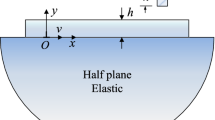Abstract
We generalize a model for friction at a sliding interface involving the motion of misfit dislocations to include the effect of thermally activated transitions across barriers. We obtain a comparatively simple form with the absolute zero-temperature Peierls barrier replaced by an effective Peierls barrier which varies exponentially with temperature, in agreement with recent experimental observations of thermally activated friction. Going further, we suggest a plausible method for generalizing the frictional drag at a more constitutive level by replacing the Peierls stress in a more general sense where the microstructure (e.g., dislocation density, grain size etc.) is built in. Last, but not least, we point out that when barriers are included the static coefficient of friction becomes larger than the dynamic coefficient of friction, which is an important connection to reality.




Similar content being viewed by others
References
Bowden, F.P., Moore, A.J.W., Tabor, D.: The ploughing and adhesion of sliding metals. J. Appl. Phys. 14(80), 80–91 (1943)
Tomlinson, G.A.: A molecular theory of friction. Philos. Mag. 7(46), 905–939 (1929)
Harrison, J.A., White, C.T., Colton, R.J., Brenner, D.W.: Molecular-dynamics simulations of atomic-scale friction of diamond surfaces. Phys. Rev. B 46(15), 9700–9708 (1992)
Landman, U., Luedtke, W.D.: Nanomechanics and dynamics of tip–substrate interactions. J. Vac. Sci. Technol. B 9(2), 414–423 (1991)
Merkle, A.P., Marks, L.D.: A predictive analytical friction model from basic theories of interfaces, contacts and dislocations. Tribol. Lett. 26(1), 73–84 (2007)
Bollmann, W.: On the geometry of grain and phase boundaries: I. General Theory. Philos. Mag. 16(140), 363–381 (1967)
Bollmann, W.: On the geometry of grain and phase boundaries, II. Applications of general theory. Philos. Mag. 16(140), 383–399 (1967)
Grimmer, H., Bollmann, W., Warrington, D.H.: Coincidence-site lattices and complete pattern-shift in cubic crystals. Acta Cryst. A 30(MAR), 197–207 (1974)
Barthel, E.: On the description of the adhesive contact of spheres with arbitrary interaction potentials. J. Colloid Interf. Sci. 200(1), 7–18 (1998)
Johnson, K.L.: Contact Mechanics. Cambridge University Press, Cambridge (1985)
Unertl, W.N.: Implications of contact mechanics models for mechanical properties measurements using scanning force microscopy. J. Vac. Sci. Technol. A 17(4), 1779–1786 (1999)
Leibfried, G.: Über den Einfluß thermisch angeregter Schallwellen auf die plastische Deformation. Z. Phys. 127, 344 (1950)
Lubenets, S.V., Startsev, V.I.: Sov. Phys. Solid State 10, 15 (1968)
Alshits, V. I.: Progress in materials science. In: Indenbom, V. L., Lothe, J. Elastic Strain Fields and Dislocation, vol. 31, p. 625. Elsevier Science, Amsterdam (1992)
Alshits, V.I.: Sov. Phys. Solid State Ussr 11(8), 1947 (1970)
Alers, G.A., Buck, O., Tittmann, B.R.: Measurements of plastic flow in superconductors and the electron-dislocation interaction. Phys. Rev. Lett. 23(6), 290–293 (1969)
Kojima, H., Suzuki, T.: Electron drag and flow stress in niobium and lead at 4.2°K. Phys. Rev. Lett. 21(13), 896–898 (1968)
Hikata, A., Elbaum, C.: Ultrasonic attenuation in normal and superconducting lead; electronic damping of dislocations. Phys. Rev. Lett. 18(18), 750–752 (1967)
Tittmann, B.R., Bommel, H.E.: Amplitude-dependent ultrasonic attenuation in superconductors. Phys. Rev. 151(1), 178–189 (1966)
Mason, W.P.: Effect of electron-damped dislocations on the determination of the superconducting energy gaps of metals. Phys. Rev. 143(1), 229–235 (1966)
Huffman, G.P., Louat, N.: Interaction between electrons and moving dislocations in superconductors. Phys. Rev. Lett. 24(19), 1055–1059 (1970)
Alshits, V.I., Shtolberg, A., Indenbom, V.L.: Stationary kink motion in the secondary Peierls relief. Phys. Stat. Sol. B 50(1), 59–69 (1972)
Alshits, V.I., Sandler, Y.M.: Flutter mechanism of dislocation drag. Phys. Stat. Sol. 64, K45–K49 (1974)
Hiratani, M., Nadgorny, E.M.: Combined model of dislocation motion with thermally activated and drag-dependent stages. Acta Mater. 49(20), 4337–4346 (2001)
Merkle, A.P., Marks, L.D.: Comment on “friction between incommensurate crystals”. Philos. Mag. Lett. 87(8), 527–532 (2007)
Dienwiebel, M., Pradeep, N., Verhoeven, G.S., Zandbergen, H.W., Frenken, J.W.M.: Model experiments of superlubricity of graphite. Surf. Sci. 576(1–3), 197–211 (2005)
Dienwiebel, M., Verhoeven, G.S., Pradeep, N., Frenken, J.W.M., Heimberg, J.A., Zandbergen, H.W.: Superlubricity of graphite. Phys. Rev. Lett. 92(12), 1261011–1261014 (2004)
Merkle, A., Marks, L.D.: Friction in full view. Appl. Phys. Lett. 90, 641011–641013 (2007)
Zhao, X., Phillpot, S.R., Sawyer, W.G., Sinnott, S.B., Perry, S.S.: Transition from thermal to athermal friction under cryogenic conditions. Phys. Rev. Lett. 102, 1861021–1861024 (2009)
Zhao, X., Perry, S. S.: Appl. Phys. Lett. (2009) (submitted)
Weertman, J., Weertman, J.R.: Elementary Dislocation Theory, 2nd edn. Oxford University Press, Oxford (1992)
Hirth, J.P., Lothe, J.: Theory of Dislocations, 2nd edn. Krieger Publishing Company, Malabar (1982)
Bulatov, V.V., Kaxiras, E.: Semidiscrete variational Peierls framework for dislocation core properties. Phys. Rev. Lett. 78(22), 4221–4224 (1997)
Hirth, J.P., Lothe, J.: Theory of Dislocations, 2nd edn. Krieger Publishing Company, Malabar, FL (1992)
Duesbery, M.: The influence of core structure on dislocation mobility. Philos. Mag. 19, 501 (1969)
Guyot, P., Dorn, J.: Can. J. Phys. 45, 983 (1967)
Nadgorny, E.: Prog. Mater. Sci. 31, 1 (1989)
Teichler, H.: Berechnung des Peierls-potentials im diamantgitter mit Hilfe der pseudopotential methode. Phys. Status Solidi b 23, 341 (1967)
Wang, G., Strachan, A., Ҫğin, T., Goddard III, W.A.: Calculating the Peierls energy and Peierls stress from atomistic simulations of screw dislocation dynamics: application to bcc tantalum, Modelling Simul. Mater. Sci. Eng. 12, S371 (2004)
Landau, A.I.: The effect of dislocation inertia on the thermally activated low-temperature plasticity of materials. I. Theory. Phys. Status Solidi a 61(2), 555–563 (1980)
Mura, T.: Micromechanics of Defects in Solid. Springer, New York (1987)
Acknowledgment
The authors would like to thank the U.S. Air Force Office of Scientific Research for funding this study on Grant number FA9550-08-1-0016.
Author information
Authors and Affiliations
Corresponding author
Rights and permissions
About this article
Cite this article
Liao, Y., Marks, L.D. Modeling of Thermal-Assisted Dislocation Friction. Tribol Lett 37, 283–288 (2010). https://doi.org/10.1007/s11249-009-9520-9
Received:
Accepted:
Published:
Issue Date:
DOI: https://doi.org/10.1007/s11249-009-9520-9




